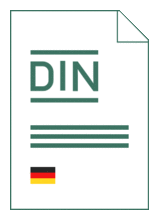
Standard [CURRENT]
DIN EN 61188-7:2017-12
Printed boards and printed board assemblies - Design and use - Part 7: Electronic component zero orientation for CAD library construction (IEC 61188-7:2017); German version EN 61188-7:2017
- German title
- Leiterplatten und Flachbaugruppen - Konstruktion und Anwendung - Teil 7: Nullorientierung elektronischer Bauelemente für CAD-Bibliotheksaufbau (IEC 61188-7:2017); Deutsche Fassung EN 61188-7:2017
- Publication date
- 2017-12
- Original language
- German
- Pages
- 21
- Publication date
- 2017-12
- Original language
- German
- Pages
- 21
- DOI
- https://dx.doi.org/10.31030/2711807
Product information on this site:
Quick delivery via download or delivery service
All transactions are encrypted
The purpose of this standard is to establishes a consistent technique for the description of electronic component orientation, and their land pattern geometries. This facilitates and encourages a common data capture and transfer methodology amongst and between global trading partners. One of the factors for creating a component description in a CAD library and standard for land patterns is to introduce a fixed zero position of the component so that all CAD images are built with the same rotation for the automation of the assembly machines. The standards for land pattern define the totality of characteristics necessary for the standardization and acceptance of a "globally binding CAD library". The main objective for the definition of a globally binding CAD library is to achieve the highest degree of "automation of electronic product development". This includes all involved processes from design and PCB layout to manufacturing, assembly and testing. This level of uniformity is required for data format standards to achieve the efficiency gains that electronic data transfer can bring to the industry. Many large companies have spent millions of dollars developing and practically applying their own distinctive standards for their own "automation of electronic product development". These standards are proprietary and not openly shared with the rest of the industry. This has resulted in massive repetition of effort costing the industry millions in wasted man-hours, creating industry chaos, and yielding no global standardization. The primary purpose for creating land pattern standards is to develop a basis for making reliable solder joints; the reason for developing the data transfer structures is to improve the effectiveness with which engineering intelligence is transformed into manufacturing reality. Even if a neutral CAD format can be used to control all manufacturing machines, this would be futile unless a standardized component description for CAD land patterns with a certain degree of uniformity is also introduced. The key role for machine automation is played by the component zero position. For the global standardization of electronic hardware development, PCB design, manufacturing, assembly and testing processes, the adoption of standards for land pattern is obvious. Any further alternative will only lead to confusion and many hours of manual intervention in order to achieve the goals of automation. Because it is so easy to export a file with one system for another system to do the work, it may also be necessary to manipulate the neutral format unnecessarily to get a clear representation of the information in the software. The design of an assembly will continue to allow the arrangement and location of components with any rotation that meets design standards. Based on a universally understandable data capture concept, there will be benefits for the entire supply chain. This standard defines the angle and origin of the land pattern for land design. The responsible committee is DKE/K 682 "Aufbau- und Verbindungstechnik für elektronische Baugruppen" ("Packaging and interconnection technology for electronic assemblies") of the DKE (German Commission for Electrical, Electronic and Information Technologies) at DIN and VDE.
This document replaces DIN EN 61188-7:2009-12 .
